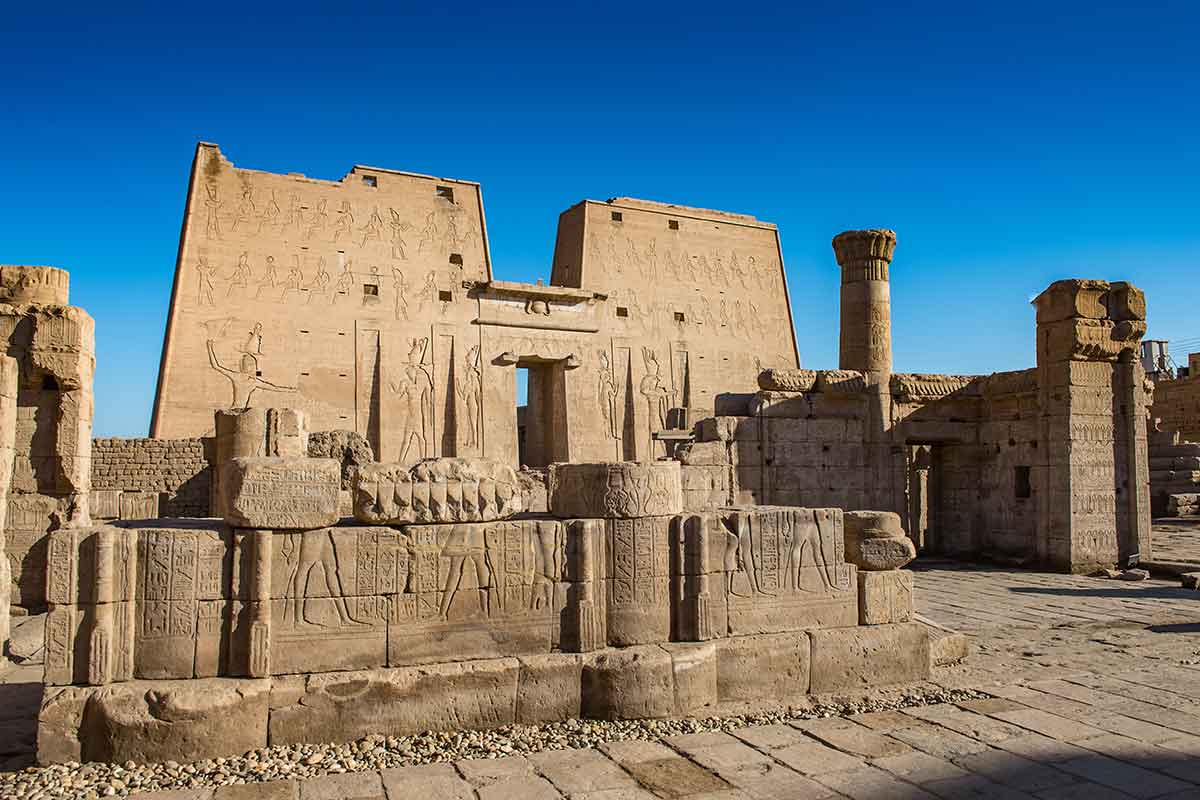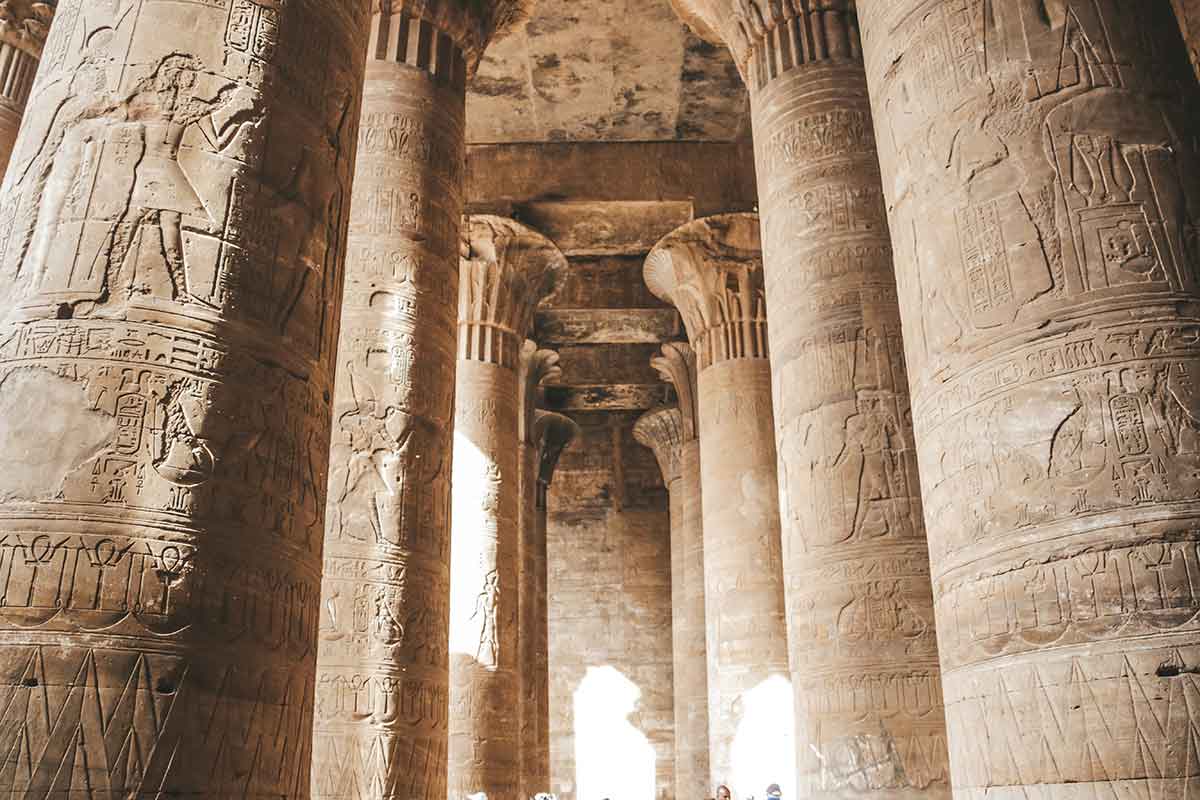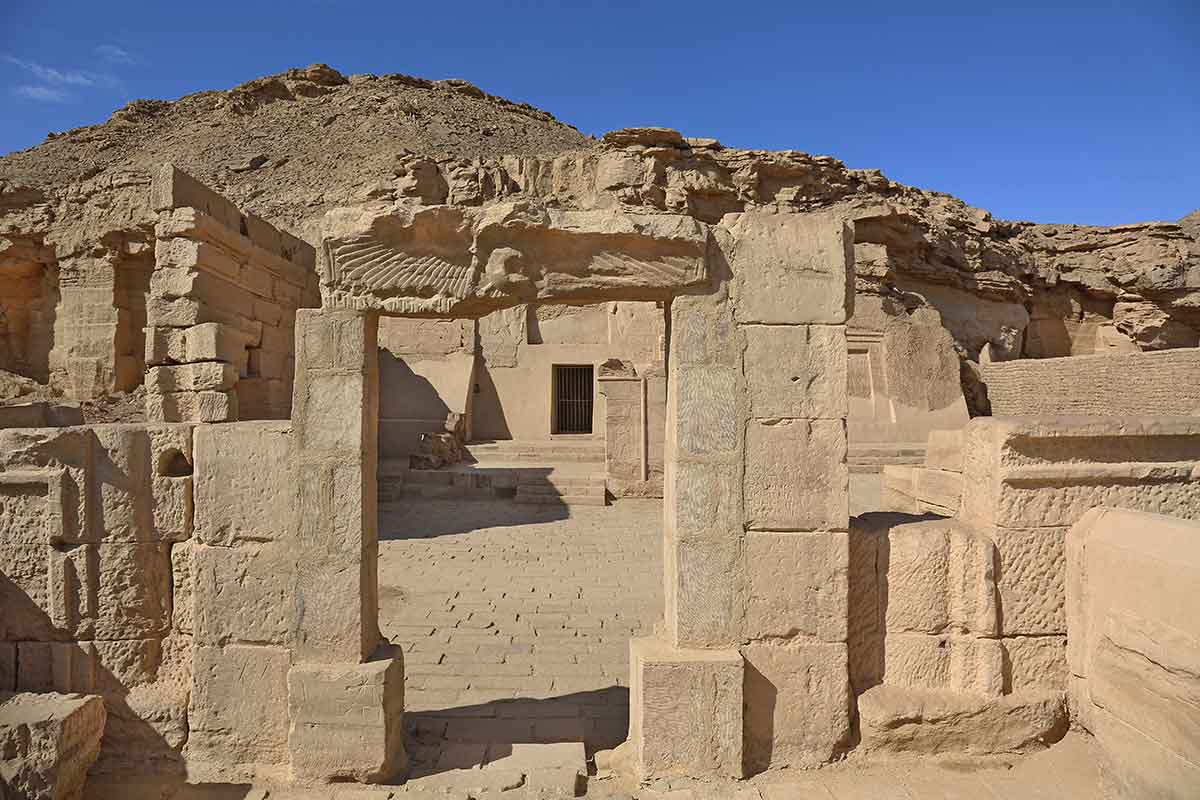The Edfu Temple is considered by many to be one of the most beautiful in all of Egypt, making it a justified excursion or a stop during a Nile cruise. This page offers information about this monument, built over two millennia ago, as well as additional suggestions that you can incorporate into your trip with Egipto Exclusivo.
Edfu is located equidistantly from Luxor (to the north) and Aswan (to the south): about 110 km separates it from each, which are the two main cities of Upper Egypt. It is part of the Aswan Governorate and is also the gateway to the Nile Valley for many travelers coming here from their holiday resorts in the Red Sea, especially those in Marsa Alam and its surroundings.
It is located at a crossroads characterized by its fertile plain, traditionally dedicated to the cultivation of sugarcane. Its population is around 130,000 inhabitants, who now also massively dedicate themselves to tourism, as the Temple of Edfu is one of the favorite visits for those traveling in the south of the country.
This visit can be made at any time of the year, including winter. In fact, this time is the favorite of many tourists, as the temperatures are warm during the day, as in the rest of the Nile Valley: about 25°C maximum, with night minimums that rarely drop below 7°C. In winter, it is advisable to protect yourself well from the heat and sun, as temperatures exceed 40°C in the central hours of the day.

The Temple of Horus at Edfu, or simply the Temple of Edfu for the vast majority of tourists, is one of the great attractions of southern Egypt. It was built in the epilogue of Ancient Egypt, in the Ptolemaic era, like some of the most famous in the country, for example, the one in Philae in Aswan or the one in Dendera in Middle Egypt.
It is primarily dedicated to the god Horus, son of Isis and Osiris, and one of the most revered in Egyptian religion. Especially by the monarchs, who considered themselves his earthly manifestation. It also had great religious significance, in conjunction with the Hathor-Isis Temple in Dendera: from here, a large river procession with the image of the god was periodically organized, going downstream to meet his mother and partner.
One of the great architects of the Temple of Horus at Edfu was Ptolemy XII, father of the famous Cleopatra, in the 1st century BC. However, its construction began a century and a half earlier, in the time of Ptolemy III. It was a time when these rulers of Egypt, of Greek dynasty, cared for the local culture by reproducing temples from the pharaonic era. The temple was probably built over other previous constructions, as elements from the New Kingdom have been discovered.
Fortunately for tourists today, it has reached us in good condition. Partly because it is relatively recent, but also because it remained semi-hidden for centuries, as the Nile floods buried its structure in mud and earth, covering it almost to the roof. In the mid-19th century, when the Egyptologist Auguste Mariette promoted its excavation and recovery, it was used as housing, a warehouse, and a stable.
Its enclosure is also one of the largest of that civilization, measuring 76 x 79 meters, and a height of 36 meters at its great entrance pylon. Therefore, the visit to the Temple of Horus at Edfu will take quite some time and will take you through different spaces, which we review below.
It is the monumental entrance to the Temple of Horus at Edfu, although now visitors enter the enclosure through a rear access. It impresses with its height and the scenes represented in relief: Ptolemy XIII subduing and striking his enemies. On the inner face of the entrance pylon are scenes of one of Horus’s great feats: avenging his father’s death at the hands of Set, his brother, and god of chaos.
Right on both sides of the entrance are two of its most famous elements: the two black granite sculptures representing the god Horus in the form of colossal falcons.
A similar statue of Horus is installed in the hypaethral hall or peristyle courtyard, the first space that the visitor encounters upon entering the Temple of Edfu, where it stands as a symbolic guardian holding the double crown of Egypt. This courtyard is an open place surrounded by columns with vegetal capitals.

After the peristyle courtyard are the two hypostyle halls, each with 12 splendid columns, decorated with reliefs that, in some cases, still retain their polychromy. From here, a corridor leads to the top of the entrance pylon, from where one can enjoy magnificent views of the city, the Nile, and its green surroundings.
It is the most sacred part of the Temple of Edfu, where the naos or granite-carved chamber is located in which the statue of the god was preserved. Also here is the sacred boat in which the divine image was taken out in river procession, reaching the Temple of Dendera for its reunion with Hathor.
Around the sanctuary of Horus are different rooms or auxiliary chapels, also decorated with reliefs and scenes of gods from Egyptian religion. An example is the New Year’s Chapel, where Nut, the goddess of the Sky, occupies almost the entire space of the ceiling.
The Temple of Edfu had its own Nilometer, that is, a subterranean chamber used to measure the Nile’s annual floods. It was something common in Upper Egypt, as there are other examples in Aswan and Kom Ombo, although also downstream, as in Cairo. It allowed to assess the pace of increase of its channel and thus understand whether it was going to be a good year for agriculture, or rather one of drought or excessive floods.
The enclosure of the Temple of Edfu also has its own House of Divine Birth or Mammisi, a structure very common in the Ptolemaic and Roman periods. Here the birth of Horus and also of the reigning monarch at that moment were celebrated.
The nighttime shows are a different and more spectacular way to enjoy the Temple of Horus at Edfu, as they are also in other famous monuments of the country, such as Abu Simbel or the temples of Luxor. In this case, the great entrance pylon is used as a surface on which to project light and sound effects, with images about the history of the temple and about ancient Egyptian civilization in general.
Although the vast majority of travelers who include Edfu in their program do so to visit the Temple of Horus, there are other places around the city that may interest some people. Places that can be visited as a plus of this excursion or as an additional stop on a Nile cruise.
Outside the walled enclosure of the Temple of Horus at Edfu, about 7 km to the south, is an archaeological site dominated by a pyramid and currently under investigation, so visits may be restricted. Its antiquity gives it great value, as it could date back to the 3rd Dynasty. Its inspiration may have been the Saqqara pyramid, as it also has a stepped profile.

El Kab is an archaeological site located about 20 km north of the Temple of Edfu, on the eastern bank of the Nile. This is its current Arabic name, but it also receives other names, which sometimes causes some confusion: the ancient Egyptians called this city Nekheb, associating it with the goddess Nejbet, while the Greeks referred to it as Eileithyiaspolis, assimilating that deity to one of their religion: Ilitía.
El Kab was the capital of the 3rd Nome of Upper Egypt during the New Kingdom, thus replacing Hierakonpolis, located just on the other side of the river. In reality, there is much work to be done in this large archaeological site, but there are already some visitable and museumized spaces. The main ones are:
The Temple of Amenhotep III: excavated in the rock of the hill and dedicated to Nejbet and Hathor, with mural decoration Tombs (hypogea) of nobles A large wall that surrounded the ancient city There are two ways to get to El Kab. One is through road 75, which passes right through the center of what was the city of Nekheb or Eileithyiaspolis. And the other is by boat, as this is a usual stop on cruises with sailing vessels (dahabiyas and feluccas), halfway between Esna and Edfu.
Despite not being a very large city, the Temple of Edfu receives many tourists each year. And this is not only due to its attractiveness but also to the various ways that exist to get there. We review them below.
The Temple of Edfu is an almost mandatory stop on all Nile cruises, so many of its visitors arrive here by boat. The most popular option is the motorboat, with greater capacity. But the most exclusive are the dahabiyas and the feluccas, which are also the traditional sailing vessels in the country since time immemorial. At Egipto Exclusivo, we can plan this premium cruise for an unforgettable experience.
Also, bear in mind that there is a distance of about 1 km on foot from the dock to the Temple of Edfu. Therefore, you will find horse-drawn carriages waiting for the arrival of tourists on their cruises, offering them this ‘transfer’ service.
It is also possible to easily reach Edfu by road. Especially if you opt for the option of a vehicle with a driver, as the possibilities of renting a car in the area are limited. The same happens with tourist buses, as large transportation companies do not usually include this destination in their routes.
On the other hand, the private vehicle with a driver offers comfort, safety, and flexibility in terms of service. This is a list of cities from which a road trip to Edfu and its temple can be organized:
Thanks to this transportation option, the Temple of Edfu is part of many tourist circuits, such as day trips or several-day excursions, in combination with other nearby places. You can contact Egipto Exclusivo for more details on this service, which our agency offers from many cities in the country.
Egypt’s main railway line runs along the entire Nile Valley, from Cairo to Aswan, passing through Edfu. Therefore, it has a station that is also used by tourists to get to know the Temple of Horus at Edfu. The most recommendable service is the overnight train, which travels at night, although you should check availability to ensure it actually stops there.
As you can see, the options for visiting the Temple of Edfu are varied. Whichever is chosen, Egipto Exclusivo will help you plan the details of the trip and the experience, with accommodation, private guides, and quality restaurants if required. We want to be your trusted agency in the country!


Fill out the form below to receive a free, no-obligation, tailor-made quote from an agency specialized in Egypt.
Travel agency and DMC specializing in private and tailor-made trips to Egypt.
Mandala Tours, S.L, NIF: B51037471
License: C.I.AN-187782-3